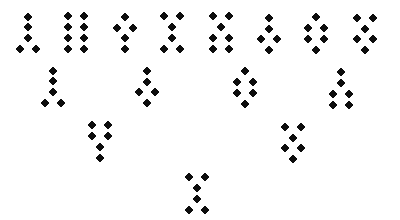The Geomantic Tableau
The Mothers
These first four figures of the geomantic tableau are called the
"mothers" or matres and are drawn horizontally from right to left:




The Daughters
The next four figures, called the "daughters" or filiae,
are created by adding the points of the mothers sideways from
right to left. For
example, here the first row of points across the mothers is
two-one-one-two, the second row is one-two-one-one, the third row
is two-two-two-two, and the last row is one-one-one-two. These four figures
are drawn next to the mothers, continuing horizontally from right to left:

The Nieces
The next four figures, sometimes called the "nieces" or neptes
are created by
adding together the points in pairs of two figures above. If there are an
even number of points, two points are put down;
if there is an odd number of points, one point is put down. For example, the
first "niece" is created by adding the points of the first and second "mothers."
Again, the geomancer proceeds from right to left:

The Witnesses and the Judge
Finally, the tableau is completed by adding points in the same
way to create
three more figures. The first two are called the "witnesses" or testes
and
the last is the "judge" or iudex (If the judge is a figure that does not
have an even number of points, a mistake has been made in the
addition, "and then must you turn again to make correction".)
A sixteenth figure called the "super judge" is sometimes drawn by "adding"
the points of the first and fifteenth figures.


